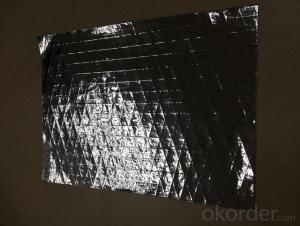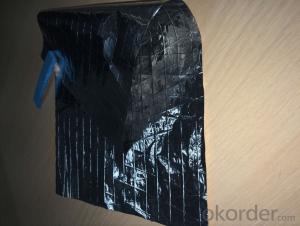Fiberglass Facing 600gsm Colored Spray Coating Tissue for Ceiling-600
- Loading Port:
- Shanghai
- Payment Terms:
- TT OR LC
- Min Order Qty:
- 500 m²
- Supply Capability:
- 100000 m²/month
OKorder Service Pledge
OKorder Financial Service
You Might Also Like
Introduction of Fiberglass Tissue
Fiberglass Tissue is a kind of facing, which is made of by the white fiberglass tissue, and special production process.
Application of Fiberglass Tissue
Our black tissue are mainly used as facing for glass wool insulation, rockwool, mineral wool etc. Also fiberglass tissue facing is used under roof decking, under attic rafters, over existing attic thermal insulation, in floors, walls and crawl spaces, and in industrial and commercial buildings to block radiant heat coming into house through the roof during the summer and retain indoor heat generated during in winter
Advantage of Fiberglass Tissue
It is the high quality heat insulating and the invincible opponent of anti- condensation. The low and stable coefficient of heat conduction has good isolation effect.
The product has many advantages, such as light weight, heat insulation, shock absorption, sound absorption and noise reduction;
The product is easy to install and process and it also waterproof, seepage control, flame retardant.
The product also has many features, such as heat resistance, low temperature resistance, chemical resistance, ageing resistance etc.
Packing of Fiberglass Tissue
1. Waterproof paper then PVC shrinking Film
2. Water-Proof film only
3. Woven cloth
4. Kraft paper or Water Proof Film then Metal/wooden pallet
5. (Also as your request. )
Pictures of Fiberglass Tissue



Specification of Fiberglass Tissue
Specification | ||
ITEM | UNIT | VALUE |
Type | C | |
Weight | g/m2 | 600±5 |
Thickness | mm | 0.40 |
Tensile Strength MD | n/125px | ≥130 |
Tensile Strength XD | n/125px | ≥90 |
Fiber Diameter | µ | 9 |
Fire Resistant Property | B1 | |
FAQ
We have organized several common questions for our clients,may help you sincerely:
1. What is the storage condition?
The Aluminum Foil Facing should be stored at room temperature and kept from wet and heat source.
2. How to guarantee the quality of the products?
We have established the international advanced quality management system,every link from raw material to final product we have strict quality test;We resolutely put an end to unqualified products flowing into the market. At the same time, we will provide necessary follow-up service assurance.
3. How long can we receive the product after purchase?
In the purchase of product within four working days, we will arrange the factory delivery as soon as possible. The specific time of receiving is related to the state and position of customers. Commonly 7 to 10 working days can be served.
- Q: This question asks for a comparison between black fiberglass tissue and other nonwoven materials, focusing on their characteristics and applications.
- <p>Black fiberglass tissue is a type of nonwoven material known for its high strength, durability, and resistance to heat and chemicals. Compared to other nonwoven materials such as polyester, polypropylene, and cellulose, black fiberglass tissue offers superior thermal insulation and sound absorption properties. It is often used in applications where these characteristics are crucial, such as in construction, automotive, and aerospace industries. While other nonwoven materials may be lighter or more cost-effective, black fiberglass tissue stands out for its ability to withstand harsh conditions and provide long-lasting performance.</p>
- Q: The question asks if it is safe to use black fiberglass tissues to clean car windows without causing scratches.
- <p>Yes, you can use black fiberglass tissues to clean your car windows without scratching them. These tissues are designed to be non-abrasive and gentle on surfaces, making them suitable for cleaning windows without causing damage. However, it's always a good idea to test a small, inconspicuous area first to ensure there is no adverse reaction. Additionally, ensure that the tissues are clean and free from any debris that could potentially scratch the glass.</p>
- Q: Is it possible to utilize black fiberglass tissue in the manufacturing of automotive components?
- <p>Yes, black fiberglass tissue can be used for automotive parts. It is known for its strength, durability, and resistance to corrosion, making it suitable for various applications in the automotive industry. Fiberglass is often used in the production of body panels, hoods, and other components where weight reduction and structural integrity are important. Its versatility allows for customization in color and texture, including black, which can be beneficial for aesthetic and functional purposes.</p>
- Q: Can black fiberglass tissues be utilized in the creation of decorative elements for outdoor use?
- <p>Yes, black fiberglass tissues can be used to create decorative elements for exteriors. Known for their durability and resistance to weather conditions, fiberglass materials are ideal for outdoor applications. They can be molded into various shapes and designs, offering a modern and sleek aesthetic. However, it's important to ensure that the fiberglass is treated with UV inhibitors to prevent fading and degradation from prolonged sun exposure. Proper installation and maintenance are also crucial to prolong the life and appearance of these decorative elements.</p>
- Q: This question asks for the most effective method to clean black fiberglass material.
- <p>The best way to clean black fiberglass tissue is by using a gentle cleaning solution and soft bristled brush. Start by mixing a mild detergent with warm water. Apply the solution to the fiberglass and gently scrub with a soft brush to avoid scratching. Rinse thoroughly with clean water and dry with a soft cloth to prevent water spots. For stubborn stains, consider using a fiberglass-specific cleaning product, but always test on a small area first to ensure it doesn't discolor the material. Regular cleaning will help maintain the appearance and longevity of black fiberglass tissue.</p>
- Q: Is it safe to use black fiberglass tissues in a microwave oven?
- <p>No, you should not use black fiberglass tissues in a microwave oven. Black fiberglass can absorb microwaves and potentially cause sparks or a fire. It is recommended to use microwave-safe materials such as glass, ceramic, or microwave-safe plastic containers when heating food in a microwave. Always check the manufacturer's guidelines for the specific microwave-safe materials and avoid using anything that could be a fire hazard.</p>
- Q: How does fiberglass facing improve insulation?
- Fiberglass facing improves insulation by providing an additional layer of protection to the insulation material. The facing acts as a barrier, preventing air and moisture from entering or escaping the insulation. This helps to maintain the desired temperature inside the insulated space, as well as preventing the growth of mold or mildew. Additionally, the facing enhances the durability and strength of the insulation, making it more resistant to damage and ensuring its longevity. It also enhances the fire resistance of the insulation, providing an added layer of safety. Overall, the fiberglass facing improves insulation by enhancing its thermal performance, moisture resistance, durability, and safety.
- Q: This question asks about the correct method to dispose of used black fiberglass tissue.
- <p>To properly dispose of used black fiberglass tissue, follow these steps: First, ensure that the tissue is dry to prevent mold growth. Place it in a sealed, heavy-duty plastic bag to contain any fibers. Avoid puncturing the bag, as fiberglass can be harmful if inhaled. Check local regulations, as some areas have specific disposal guidelines for hazardous waste. If your local waste management facility accepts hazardous waste, take the bag there for proper disposal. If not, contact a professional hazardous waste disposal service. Always wear protective gear, such as gloves and a mask, when handling fiberglass to minimize skin and respiratory exposure.</p>
- Q: Is it possible to utilize black fiberglass tissue as a material for flooring?
- <p>Black fiberglass tissue can indeed be used as a flooring material, but it is typically not the primary choice due to its composition and properties. Fiberglass is known for its strength and durability, but it is not designed to withstand the wear and tear of foot traffic over time. It is more commonly used in applications such as insulation, reinforcement, and certain industrial settings. For flooring, materials like vinyl, linoleum, or wood are more suitable as they are specifically engineered to resist the impacts and pressures associated with foot traffic and provide a comfortable, safe surface for walking.</p>
- Q: Is it possible to use black fiberglass tissue for painting on surfaces?
- <p>Yes, black fiberglass tissue can be used for painting surfaces. It is often used as a substrate for various applications, including painting. To prepare the surface for painting, it should be cleaned thoroughly and possibly primed to ensure proper adhesion of the paint. The type of paint used will depend on the specific requirements of the project, such as durability, weather resistance, and aesthetic preferences.</p>
Send your message to us
Fiberglass Facing 600gsm Colored Spray Coating Tissue for Ceiling-600
- Loading Port:
- Shanghai
- Payment Terms:
- TT OR LC
- Min Order Qty:
- 500 m²
- Supply Capability:
- 100000 m²/month
OKorder Service Pledge
OKorder Financial Service
Similar products
Hot products
Hot Searches
Related keywords



























